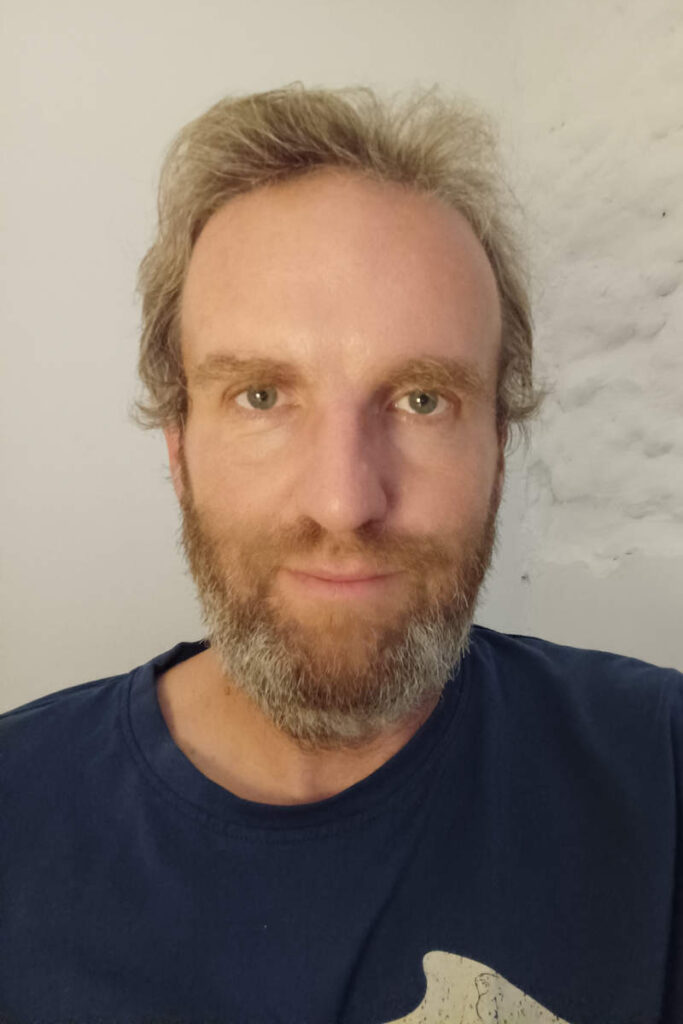Invited by the association L’union fait la force 88, the researcher and mathematician Vincent Pavan* gave a conference in Épinal: “Covid-19: mathematical and epidemiological corruptions”. A thorough dissection of the scientific frauds of the crisis.
Par Alix Jouan

“You can debate everything but the numbers,” the government ad for the summer of 2021 peremptorily asserted. But Vincent Pavan does not share this opinion. This mathematics researcher is well placed to know that numbers can be made to say whatever you want, especially if you fiddle with them a little, even a lot. He clearly demonstrated this during his conference in Épinal: “Covid-19: mathematical and epidemiological corruptions”. A powerful synthesis of what he denounces as two years of scientific fraud.
Delusional simulations
To begin, let’s go back in time. We are in 2009 and the H1N1 flu pandemic is announced. It was the dress rehearsal for Covid,” says Vincent Pavan. All the ingredients were already there, with a total exaggeration of the danger of the virus, established on the basis of delirious simulations announcing millions of deaths. These projections are primarily the work of Neil Ferguson, an epidemiologist at Imperial College London, who is already known for having announced a greatly overestimated mortality rate during the 2005 bird flu outbreak [1].
In France, the same type of mathematical model was used at the time by the Institut de veille sanitaire and Inserm, or by the Ecole des hautes études en santé publique. The figures produced are so out of touch that the Senate’s commission of inquiry into the management of the H1N1 pandemic noted in its excellent 2010 report that “the lack of correlation between the modelled estimates and the observed reality is striking” and that “the hypotheses formulated on the basis of the models have no predictive value”. In short, scientific bullshit. The case seems to be heard.
But in 2020, it’s back to the drawing board. Neil Ferguson and his simulations are back to announce millions of deaths, including 500,000 for France. “In fact, he modeled from an old code from 2006, vaguely adapted,” comments Vincent Pavan, “and he wrote a report, the ‘Report 9′, which is not a peer-reviewed scientific article, but just a document from Imperial College. And our mathematician explains that this code contains so many input parameters (930 in total) that it can be made to say anything and everything. In statistics, this is called “overfitting” or “overinterpretation”: the more parameters a model contains, the less reliable it is able to generalize and predict.
Starting biases
Moreover, mathematics has its limits: “It is rather tautological and is used mainly to demonstrate that a four-legged animal is a quadruped,” explains the speaker. In other words, the result of the formulas at the end depends on the data entered in the formulas at the beginning. Any hypothesis omitted or discarded from the outset will therefore be absent from the final result, which is inevitably biased. For example, for the 2009 models, the Senate report emphasizes that at no time “was it considered that the A (H1N1) virus could be less virulent than the seasonal flu”. This is very interesting…
Similarly, in 2020, Ferguson assumes that the only way to slow or stop the Covid-19 epidemic is to implement non-pharmaceutical interventions (isolation, quarantine, social distancing measures…) until a vaccine arrives. Oddly, no treatment is being considered. And, even more bizarrely, the inevitable arrival of the lifesaving vaccine is scheduled 18 months later. How does he know?” wonders Vincent Pavan, while the development of a vaccine usually takes about ten years.
Commissions more than science
That’s when another actor enters the French scene: Simon Cauchemez. A member of the famous scientific council that should inform the decisions of our leaders, he is a student of Ferguson’s who was hired in 2013 at the Pasteur Institute to found the Mathematical Modeling of Infectious Diseases Unit. In an opinion of the scientific council of March 12, 2020, Simon Cauchemez endorses the simulations of his master and takes up the recommendations of Report 9, namely a series of barrier measures and alternating periods of containment and decontainment while waiting for a vaccine. This will be done.
In the meantime, Simon Cauchemez was asked to demonstrate the effectiveness of containment. Let’s be clear: “This is an order, it’s not science,” says our researcher. The order was carried out in May 2020 with a first study published in Science and co-signed by Cauchemez. Vincent Pavan demolishes it in two sentences: “This article is one of the biggest scientific scams of the 21st century. It contains almost a mathematical error in every line”. What a shame! Moreover, the authors rely on the R0 theory (basic reproduction rate of the disease), itself derived from the 1927 theory of Kermack and McKendrick. These theories simplify reality and do not take into account human diversity, especially the existence of super-contaminators, which will however be admitted later on during the crisis.
No doubt to complete the order, Cauchemez will sign another article published in September 2020 in The Lancet. This one will conclude without surprise that the containment measures in France were successful.
The “chimera” of herd immunity
In October 2020, Simon Cauchemez and Arnaud Fontanet (another epidemiologist member of the Scientific Advisory Board and of the Institut Pasteur) published an article in Nature on the collective immunity to be achieved to control the Covid-19 epidemic. For Vincent Pavan, herd immunity is neither more nor less than a “scientific chimera”. Moreover, the two authors rely once again on the questionable theory of R0 and “proceed to seemingly complicated calculations, but which ultimately boil down to a rule of 3” to estimate the percentage of herd immunity to be achieved in order to stop the spread of the disease, “and this, without taking into account the low contagiousness of Sars-CoV-2 nor its very low lethality”. Most importantly, they promote vaccination as the safest way to achieve an effective threshold of herd immunity, provided that at least 70% of the population is vaccinated with two doses. This assertion will be used to justify the entire mass vaccination policy that will be implemented thereafter. In reality, this vaccination rate will be reached in France in September 2021, with absolutely no effect. It has been known ever since that the vaccine does not prevent transmission and that its effectiveness is very relative, which was never envisaged by the authors. Between theory and reality, there is a gulf.
A survey instead of a scientific study
Another example of scientific fraud pointed out by Pavan: the ComCor study by Fontanet et al, which was used to justify, after the fact (!!!), the closure of bars and restaurants in France. It is difficult not to see it as an order from the government, to whom the cafe owners and restaurant owners had been asking for weeks on what scientific evidence he had taken his decision. In fact, the scientific study is a survey conducted in partnership with the Cnam and the Ipsos Institute on the lifestyle of the French, with a cohort of Covid patients and a cohort of non patients. From their answers, the study tries to determine the places of life most likely to be contaminated. This method is not very scientific in itself: why not have taken microbiological samples in the field instead? Moreover, Vincent Pavan has noted contradictions in the figures presented, leading to aberrations. The mathematician submitted a counter-expertise, which has not been answered, but which has obviously been taken into account by the authors, since the version of the study published in The Lancet in June 2021 no longer contains the contradictory figures. However, it is impossible to access all the data of the study to verify the calculations… The association Réinfo Liberté, chaired by Vincent Pavan, and the association Bon Sens will eventually file a criminal complaint against X for forgery, swindling and influence peddling.
An unverifiable pre-publication
The same goes for the pre-publication signed Bosetti et al (and in which we find Cauchemez and Fontanet) put online on June 28, 2021 on the Institut Pasteur website. Based on a so-called mathematical model, it shows that unvaccinated people are 12 times more contagious than vaccinated people. Although not peer-reviewed (and it will never be), this pre-publication will nevertheless serve as a scientific guarantee for the government to put in place the health pass as of the following month. However, nothing in this study stands up, says Vincent Pavan, who torpedoed it on July 22, 2021 at the public meeting n°15 of the Independent Scientific Council. “The conclusions only confirm the initial hypotheses, the equations are illegible with typographical errors and missing terms, moreover they compare cabbages and carrots, and it is impossible to access the codes used to verify them. How could it get any worse?
Once again, the criticism of our “impediment to turning in circles” seems to have been partly heard, since a second version of the article will be put online on September 6, 2021 with a slight modification: the non-vaccinated are now only 4 times more contagious than the vaccinated. But how did the authors arrive at this new result? We don’t know any more than with the first version. A new complaint against X was filed by Réinfo Liberté with the Paris Public Prosecutor’s Office. Both cases, defended by Ludovic Heringuez, are still in progress. But a problem appears: is the justice system capable of deciding on questions that are basically a matter of scientific debate?
* Vincent Pavan is a lecturer and researcher in mathematics at the University of Aix-Marseille, Polytech department. He is also a member of the Independent Scientific Council, president of the association Réinfo Liberté and co-author with Ariane Bilheran of the book “Le débat interdit – Langage, Covid et totalitarisme” (2022, Guy Trédaniel Editeur).
[1] Neil Ferguson predicted up to 200 million deaths worldwide from H5N1 bird flu in an interview with the Guardian in August 2005

